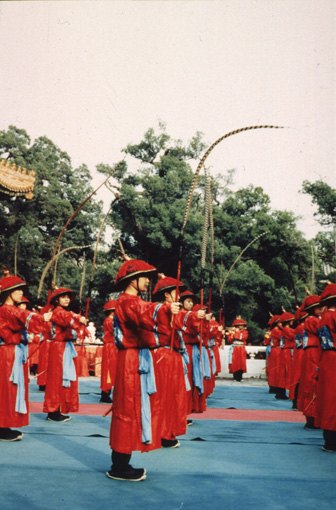

The first thing shown is a closeup of the Hymnal Record. As the Proclamation Hymn plays in the background, the six rows of six dancers perform. The dancers all have a pheasant feather and reed pipe. The primary ritual officer performs the first sacrifice. After bowing (ke tou), he first offers incense. Next, he offers the silk damask. Finally, he offers the wine, or libation. To end the offering, he bows three times to the altar.
Proclamation Hymn
We cherish his brilliant virtue;
Jades chime, bells respond
After it was determined that the sacrifice to Kongzi would follow the regulations of the imperial sacrifices at the Altar of Soils and Grains, the sacrifice required six rows of dancers and three racks of hanging bells and jade chimes. At this time, Kongzi’s rank in the sacrificial hierarchy was upper lord; in 723, however, the sacrifices were accompanied by four racks of bells and chimes. Shortly afterward in 739, Kongzi’s title was elevated to king. In this particular occurrence, two rows of bells and chimes are used.
During the Ming, ritualists elevated Kongzi's ritual status by sacrificing to him as though he were king. Arguing that Kongzi's cap and robe were already appropriate for an emperor, they argued that the number of ritual dancers was inconsistent and instead corresponded to a feudal lord. In 1477, the court granted Zhou's request and Kongzi received twelve sacrificial vessels and eight rows of dancers, rather than the previous ten vessels and six rows.
Formation of the Liturgy
The first state temple devoted to Kongzi was built in the Liu-Song (420-479), but it is unclear when the imperial court began observing a codified liturgy in Confucian temples. Early records indicate that the imperial cult was undergoing a gradual formation during the North-South division and the Sui History describes a full liturgy for a Venerable Kong Temple at the court of the Latter Qi (550-77).
During the Tang, detailed codes for sacrifices to Kongzi were established and later used as the basis of the liturgy used throughout imperial China. These codes were developed from canonical texts of ritual and stated that Kongzi and the other spirits in the main hall received three offerings. The first offering was presented by the crown prince, while the second and final offerings by the two top officials of the Directorate of Education, the Libationer and Director of Studies. Though developed during the Tang, the ritual procedures and offerings changed slightly throughout imperial China. In this occurrence of the ritual, the same person presents all three of the main offerings to Kongzi.
Six Rows of Six Dancers

Dancers at the temple in Beijing
The number of dancers present during a ceremony was indicative of the importance, or level, of the ceremony. During the Liu-Song in 445, the court set the number of rows of dancers at six, which was the appropriate number for ceremonies honoring dukes.
Confucius said of the Ji Family, “They have eight rows of dancers performing in their courtyard. If they can condone this, what are they not capable of? According to later ritual texts, different ranks in society were allowed different numbers of dancers to perform outside the ancestral hall during ceremonial occasions: the Son of Heaven allowed eight rows of eight dancers, feudal lords six rows, ministers four rows, and official two rows...his use of eight dancers thus represented an outrageous usurpation of the ritual prerogatives of the Zhou king” Analects 3.1
The first attempt to standardize music and dance was in 485. Emperor Wu (r. 479-502) ordered a performance of the Confucian Ceremonial, but found that the ritual and musical procedures were not yet standardized. At this point, the standardization of music and dance for the ritual ceremony began and the dance was choreographed in the six-row format, performed by thirty-six dancers in six rows of six.
Toward the end of the Eastern Han, the ritual sacrifice to Confucius was determined to follow the regulations of the imperial sacrifices at the Altar of Soils and Grains. During this time, Kongzi’s rank in the court sacrificial hierarchy was “upper lord” (shang hou), which required the six rows of six dancers.
During the imperial sacrifice, the most promising students traditionally performed the ceremonial dance of the ‘Six Rows’ in front of the Hall of Great Completion. In this particular ritual, the young boys were selected from a local school to perform the dance.